Air con Peugeot 508 2011 - RHD (UK, Australia) User Guide
[x] Cancel search | Manufacturer: PEUGEOT, Model Year: 2011, Model line: 508, Model: Peugeot 508 2011Pages: 340, PDF Size: 25.76 MB
Page 60 of 340
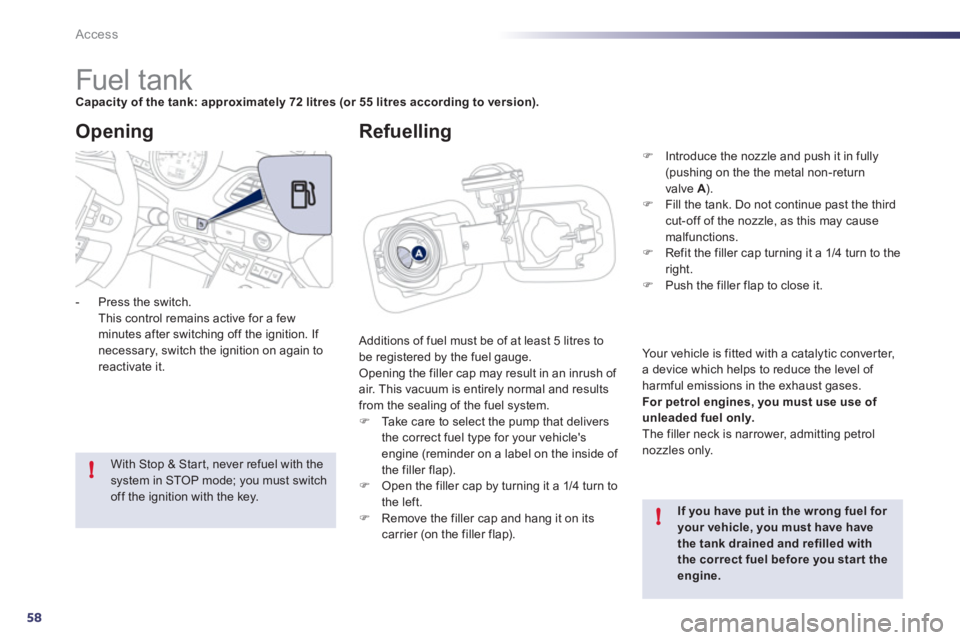
58
!
!
Access
Fuel tank
Capacity of the tank: approximately 72 litres
(or 55 litres according to version).
Additions of fuel must be of at least 5 litres to
be registered by the fuel gauge.
Opening the filler cap may result in an inrush of
air. This vacuum is entirely normal and results
from the sealing of the fuel system.
�)
Take care to select the pump that delivers
the correct fuel type for your vehicle's
engine (reminder on a label on the inside of
the filler flap).
�)
Open the filler cap by turning it a 1/4 turn to
the left.
�)
Remove the filler cap and hang it on its
carrier (on the filler flap).
Opening
If you have put in the wrong fuel for
your vehicle, you must have have
the tank drained and refilled with
the correct fuel before you star t the
engine.
With Stop & Star t, never refuel with the
system in STOP mode; you must switch
off the ignition with the key.
- Press the switch.
This control remains active for a few
minutes after switching off the ignition. If
necessary, switch the ignition on again to
reactivate it.
Refuelling
�)
Introduce the nozzle and push it in fully
(pushing on the the metal non-return
valve A
).
�)
Fill the tank. Do not continue past the third
cut-off of the nozzle, as this may cause
malfunctions.
�)
Refit the filler cap turning it a 1/4 turn to the
right.
�)
Push the filler flap to close it.
Your vehicle is fitted with a catalytic conver ter,
a device which helps to reduce the level of
harmful emissions in the exhaust gases.
For petrol engines, you must use use of
unleaded fuel only.
The filler neck is narrower, admitting petrol
nozzles only.
Page 77 of 340
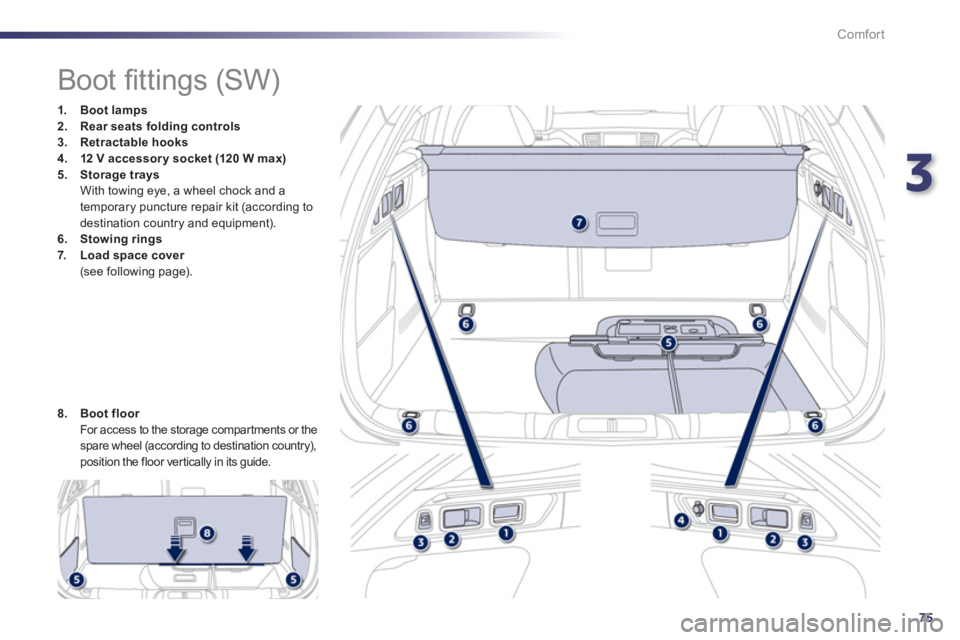
3
75
Comfort
Boot fi ttings (SW)
1.
Boot lamps
2.
Rear seats folding controls
3.
Retractable hooks
4.
12 V accessor y socket (120 W max)
5.
Storage
trays
With towing eye, a wheel chock and a
temporary puncture repair kit (according to
destination country and equipment).
6.
Stowing rings
7.
Load space cover
(see following page) .
8.
Boot floor
For access to the storage compar tments or the
spare wheel (according to destination country),
position the floor ver tically in its guide.
Page 82 of 340
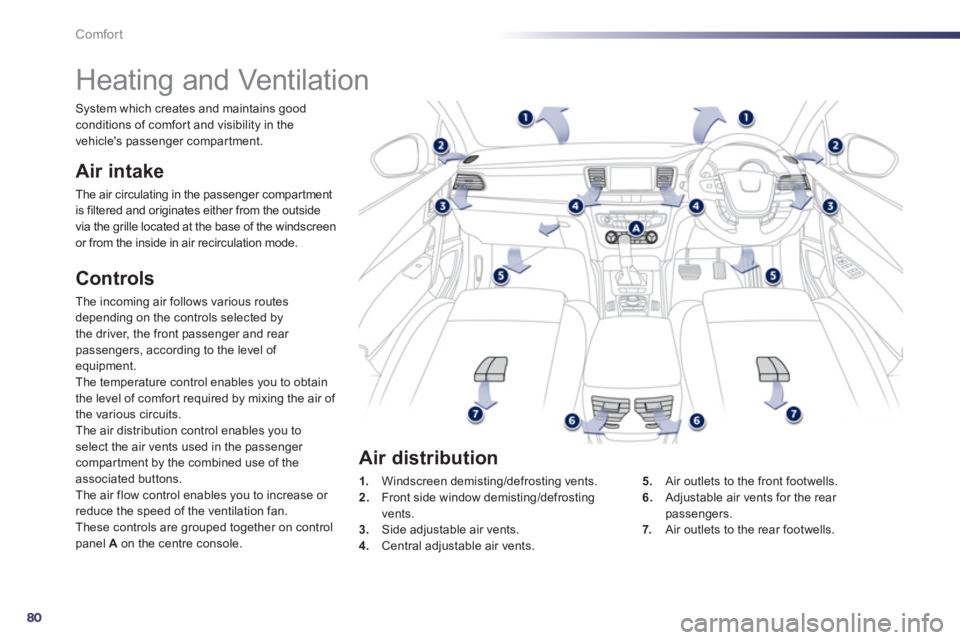
80
Comfort
Heating and Ventilation
Air intake
The air circulating in the passenger compar tment
is filtered and originates either from the outside
via the grille located at the base of the windscreen
or from the inside in air recirculation mode.
Controls
The incoming air follows various routes
depending on the controls selected by
the driver, the front passenger and rear
passengers, according to the level of
equipment.
The temperature control enables you to obtain
the level of comfor t required by mixing the air of
the various circuits.
The air distribution control enables you to
select the air vents used in the passenger
compar tment by the combined use of the
associated buttons.
The air flow control enables you to increase or
reduce the speed of the ventilation fan.
These controls are grouped together on control
panel A
on the centre console.
1.
Windscreen demisting/defrosting vents.
2.
Front side window demisting/defrosting
vents.
3.
Side adjustable air vents.
4.
Central adjustable air vents.
5.
Air outlets to the front footwells.
6.
Adjustable air vents for the rear
passengers.
7.
Air outlets to the rear footwells.
Air distribution
System which creates and maintains good
conditions of comfor t and visibility in the
vehicle's passenger compar tment.
Page 83 of 340
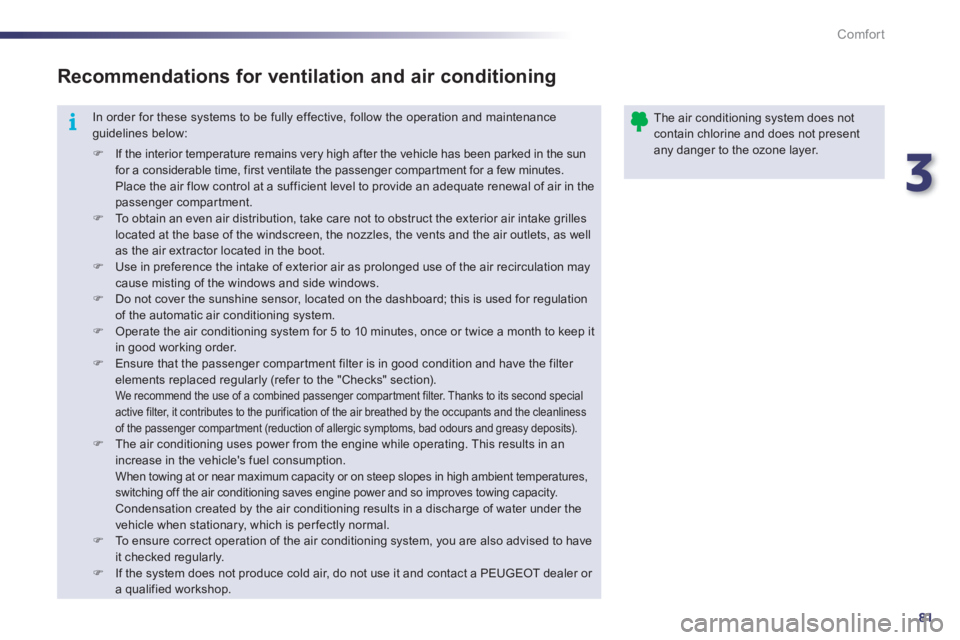
3
81
i
Comfort
In order for these systems to be fully effective, follow the operation and maintenance
guidelines below:
�)
If the interior temperature remains very high after the vehicle has been parked in the sun
for a considerable time, first ventilate the passenger compartment for a few minutes.
Place the air flow control at a sufficient level to provide an adequate renewal of air in the
passenger compartment.
�)
To obtain an even air distribution, take care not to obstruct the exterior air intake grilles
located at the base of the windscreen, the nozzles, the vents and the air outlets, as well
as the air extractor located in the boot.
�)
Use in preference the intake of exterior air as prolonged use of the air recirculation may
cause misting of the windows and side windows.
�)
Do not cover the sunshine sensor, located on the dashboard; this is used for regulation
of the automatic air conditioning system.
�)
Operate the air conditioning system for 5 to 10 minutes, once or twice a month to keep it
in good working order.
�)
Ensure that the passenger compartment filter is in good condition and have the filter
elements replaced regularly (refer to the "Checks" section).
We recommend the use of a combined passenger compartment filter. Thanks to its second special
active filter, it contributes to the purification of the air breathed by the occupants and the cleanliness
of the passenger compartment (reduction of allergic symptoms, bad odours and greasy deposits).
�)
The air conditioning uses power from the engine while operating. This results in an
increase in the vehicle's fuel consumption.
When towing at or near maximum capacity or on steep slopes in high ambient temperatures,
switching off the air conditioning saves engine power and so improves towing capacity.
Condensation created by the air conditioning results in a discharge of water under the
vehicle when stationary, which is per fectly normal.
�)
To ensure correct operation of the air conditioning system, you are also advised to have
it checked regularly.
�)
If the system does not produce cold air, do not use it and contact a PEUGEOT dealer or
a qualified workshop.
Recommendations for ventilation and air conditioning
The air conditioning system does not
contain chlorine and does not present
any danger to the ozone layer.
Page 84 of 340
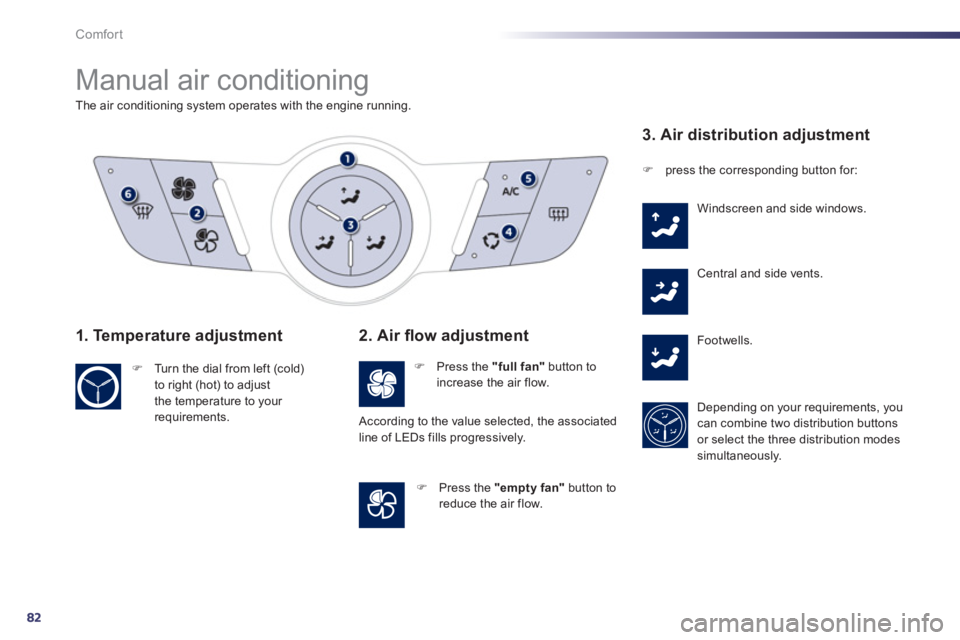
82
Comfort
Manual air conditioning
The air conditioning system operates with the engine running.
1. Temperature adjustment
�)
Turn the dial from left (cold)
to right (hot) to adjust
the temperature to your
requirements.
2. Air fl ow adjustment
�)
Press the "full fan"
button to
increase the air flow.
�)
Press the "empty fan"
button to
reduce the air flow.
3. Air distribution adjustment
�)
press the corresponding button for:
Windscreen and side windows.
Central and side vents.
Footwells.
Depending on your requirements, you
can combine two distribution buttons
or select the three distribution modes
simultaneously. According to the value selected, the associated
line of LEDs fills progressively.
Page 85 of 340
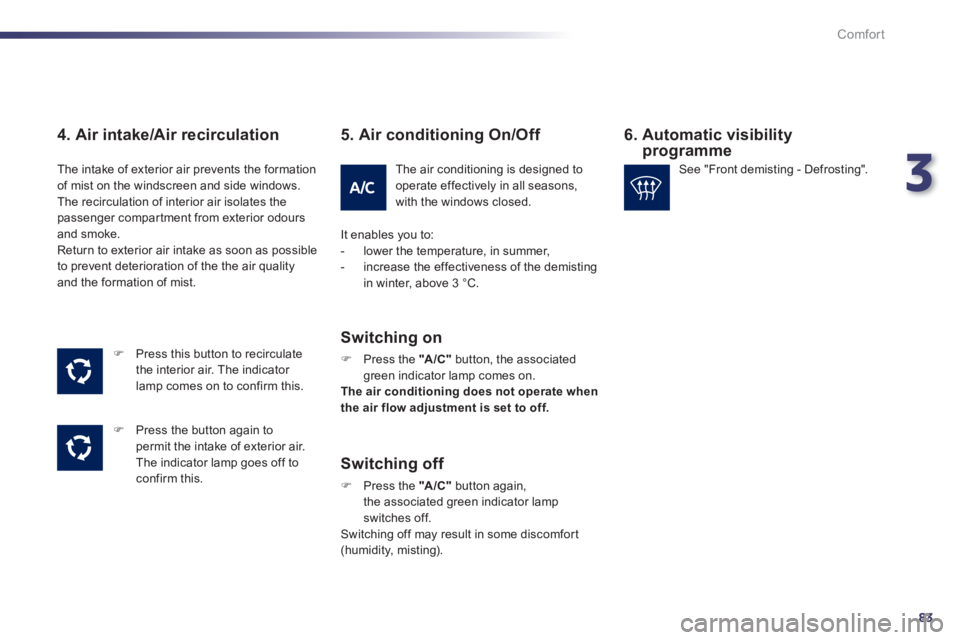
3
83
Comfort
4. Air intake/Air recirculation
�)
Press this button to recirculate
the interior air. The indicator
lamp comes on to confirm this.
�)
Press the button again to
permit the intake of exterior air.
The indicator lamp goes off to
confirm this.
The intake of exterior air prevents the formation
of mist on the windscreen and side windows.
The recirculation of interior air isolates the
passenger compar tment from exterior odours
and smoke.
Return to exterior air intake as soon as possible
to prevent deterioration of the the air quality
and the formation of mist.
6. Automatic visibility
programme
5. Air conditioning On/Off
The air conditioning is designed to
operate effectively in all seasons,
with the windows closed.
It enables you to:
- lower the temperature, in summer,
- increase the effectiveness of the demisting
in winter, above 3 °C.
Switching on
�)
Press the "A /C "
button, the associated
green indicator lamp comes on.
The air conditioning does not operate when
the air flow adjustment is
set to
off.
Switching off
�)
Press the "A /C "
button again,
the associated green indicator lamp
switches off.
Switching off may result in some discomfor t
(humidity, misting).
See "Front demisting - Defrosting".
Page 86 of 340
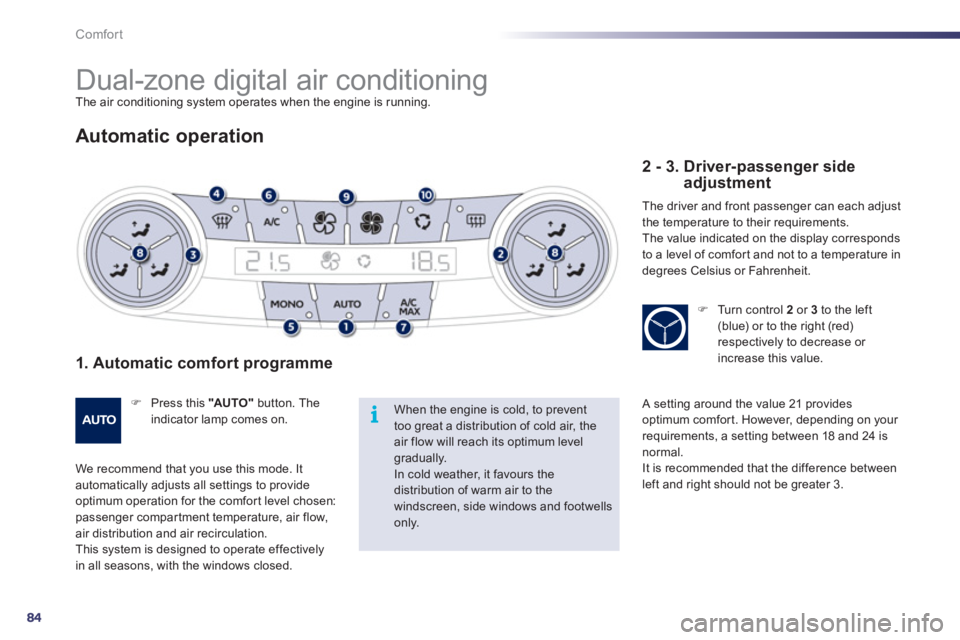
84
i
Comfort
Dual-zone digital air conditioning
The air conditioning system operates when the engine is running.
Automatic operation
1. Automatic comfort programme
�)
Press this "AU TO "
button. The
indicator lamp comes on.
We recommend that you use this mode. It
automatically adjusts all settings to provide
optimum operation for the comfor t level chosen:
passenger compar tment temperature, air flow,
air distribution and air recirculation.
This system is designed to operate effectively
in all seasons, with the windows closed.
When the engine is cold, to prevent
too great a distribution of cold air, the
air flow will reach its optimum level
gradually.
In cold weather, it favours the
distribution of warm air to the
windscreen, side windows and footwells
only.
2 - 3. Driver-passenger side
adjustment
The driver and front passenger can each adjust
the temperature to their requirements.
The value indicated on the display corresponds
to a level of comfor t and not to a temperature in
degrees Celsius or Fahrenheit.
�)
Turn control 2
or 3
to the left
(blue) or to the right (red)
respectively to decrease or
increase this value.
A setting around the value 21 provides
optimum comfort. However, depending on your
requirements, a setting between 18 and 24 is
normal.
It is recommended that the difference between
left and right should not be greater 3.
Page 87 of 340
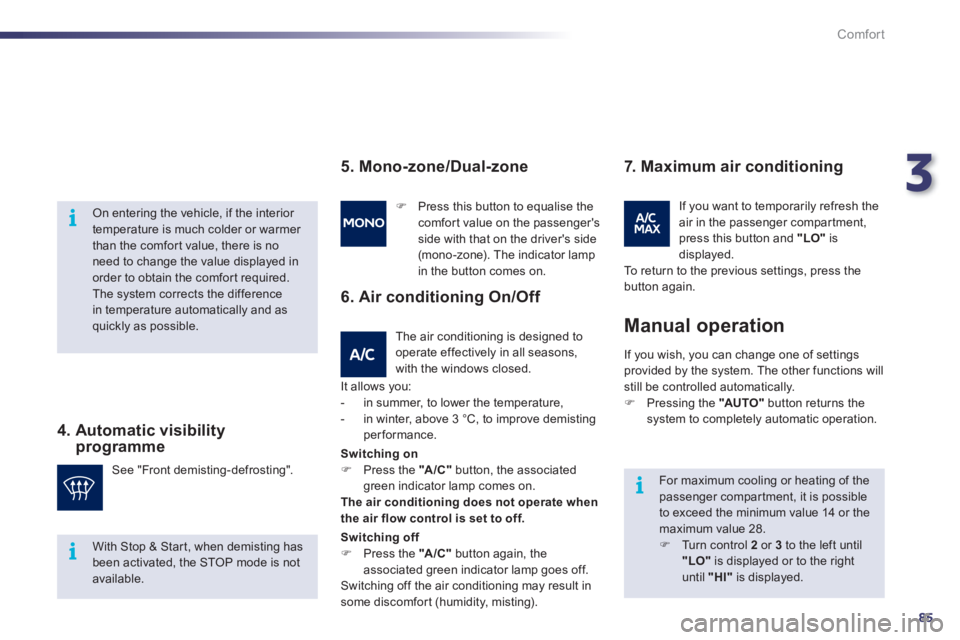
3
85
i
i
i
Comfort
On entering the vehicle, if the interior
temperature is much colder or warmer
than the comfor t value, there is no
need to change the value displayed in
order to obtain the comfor t required.
The system corrects the difference
in temperature automatically and as
quickly as possible.
4. Automatic visibility
programme
For maximum cooling or heating of the
passenger compar tment, it is possible
to exceed the minimum value 14 or the
maximum value 28.
�)
Turn control 2
or 3
to the left until
"LO"
is displayed or to the right
until "HI"
is displayed. See "Front demisting-defrosting".
�)
Press this button to equalise the
comfor t value on the passenger's
side with that on the driver's side
(mono-zone). The indicator lamp
in the button comes on.
If you wish, you can change one of settings
provided by the system. The other functions will
still be controlled automatically.
�)
Pressing the "AU TO "
button returns the
system to completely automatic operation.
Manual operation
5. Mono-zone/Dual-zone
The air conditioning is designed to
operate effectively in all seasons,
with the windows closed.
6. Air conditioning On/Off
It allows you:
- in summer, to lower the temperature,
- in winter, above 3 °C, to improve demisting
performance.
7. Maximum air conditioning
If you want to temporarily refresh the
air in the passenger compar tment,
press this button and "LO"
is
displayed.
To return to the previous settings, press the
button again.
With Stop & Star t, when demisting has
been activated, the STOP mode is not
available.
Switching on
�)
Press the "
A/C
"
button, the associated
green indicator lamp comes on.
The air conditioning does not operate when
the air flow control is set to off.
Switching off
�)
Press the "A /C "
button again, the
associated green indicator lamp goes off.
Switching off the air conditioning may result in
some discomfor t (humidity, misting).
Page 88 of 340
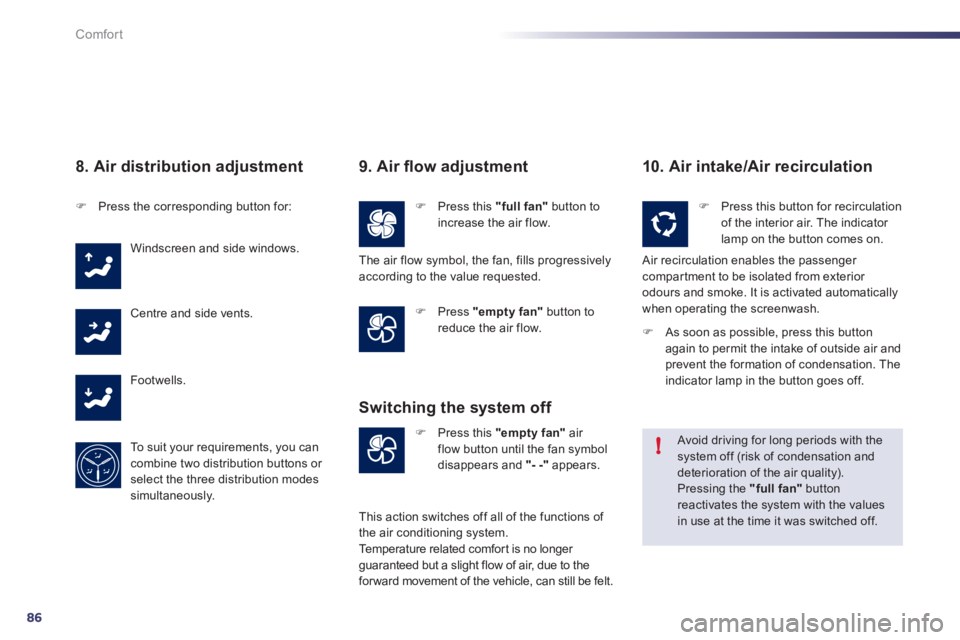
86
!
Comfort
8. Air distribution adjustment
�)
Press the corresponding button for:
Windscreen and side windows.
Centre and side vents.
Footwells.
To suit your requirements, you can
combine two distribution buttons or
select the three distribution modes
simultaneously.
9. Air fl ow adjustment
�)
Press this "full fan"
button to
increase the air flow.
�)
Press "empty fan"
button to
reduce the air flow.
10. Air intake/Air recirculation
�)
Press this "empty fan"
air
flow button until the fan symbol
disappears and "- -"
appears.
Switching the system off
�)
Press this button for recirculation
of the interior air. The indicator
lamp on the button comes on.
Air recirculation enables the passenger
compar tment to be isolated from exterior
odours and smoke. It is activated automatically
when operating the screenwash.
Avoid driving for long periods with the
system off (risk of condensation and
deterioration of the air quality).
Pressing the "full fan"
button
reactivates the system with the values
in use at the time it was switched off. The air flow symbol, the fan, fills progressively
according to the value requested.
This action switches off all of the functions of
the air conditioning system.
Temperature related comfor t is no longer
guaranteed but a slight flow of air, due to the
for ward movement of the vehicle, can still be felt.
�)
As soon as possible, press this button
again to permit the intake of outside air and
prevent the formation of condensation. The
indicator lamp in the button goes off.
Page 89 of 340
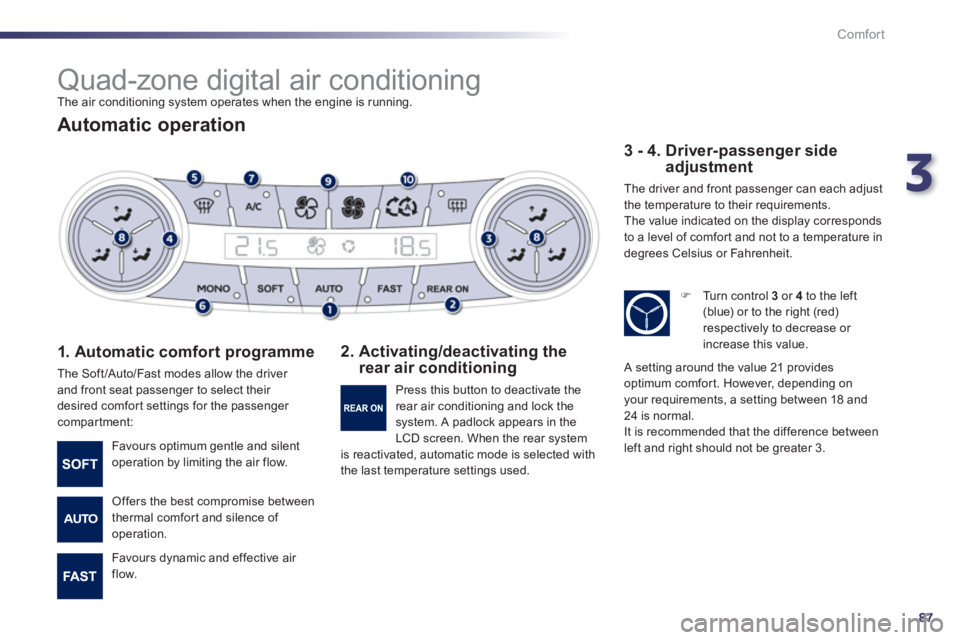
3
87
Comfort
Quad-zone digital air conditioning
The air conditioning system operates when the engine is running.
Automatic operation
1. Automatic comfort programme
The Soft /Auto/Fast modes allow the driver
and front seat passenger to select their
desired comfor t settings for the passenger
compartment:
2. Activating/deactivating the
rear air conditioning
3 - 4. Driver-passenger side
adjustment
The driver and front passenger can each adjust
the temperature to their requirements.
The value indicated on the display corresponds
to a level of comfor t and not to a temperature in
degrees Celsius or Fahrenheit.
Favours optimum gentle and silent
operation by limiting the air flow.
Offers the best compromise between
thermal comfor t and silence of
operation.
Favours dynamic and effective air
flow. Press this button to deactivate the
rear air conditioning and lock the
system. A padlock appears in the
LCD screen. When the rear system
is reactivated, automatic mode is selected with
the last temperature settings used.
�)
Turn control 3
or 4
to the left
(blue) or to the right (red)
respectively to decrease or
increase this value.
A setting around the value 21 provides
optimum comfor t. However, depending on
your requirements, a setting between 18 and
24 is normal.
It is recommended that the difference between
left and right should not be greater 3.